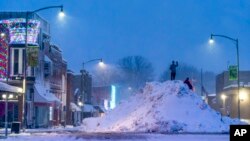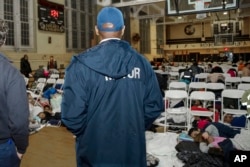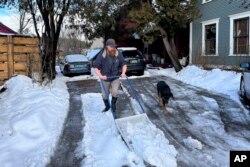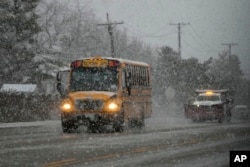A major storm drenched the Northeast and slammed it with fierce winds, knocking out power to hundreds of thousands following a bout of violent weather that struck most of the U.S.
The storm, which started Tuesday night and was moving out Wednesday, washed out roads and took down trees and power lines. Wind gusts reached 72 kph to 88 kph and more windy weather was expected throughout Wednesday.
It followed a day of tornadoes and deadly accidents in the South and blizzards in the Midwest and Northwest. In some parts of the Pacific Northwest and the Rockies, more than about 75 centimeters of snow fell.
Here's how various areas are being affected by the storms:
New Jersey
New Jersey Gov. Phil Murphy declared a state of emergency ahead of the storm. Many streets and roads were flooded, and rivers were rising after some areas got up to 7.6 centimeters of rain since Tuesday night. The rain fell on ground saturated by another storm a few weeks ago. Another storm is forecast for the weekend.
Lou DeFazio, 65, of Manville, New Jersey, lives steps away from the Millstone River that flooded disastrously in 2021 after the remnants of Ida slammed into the state and swerved riverbanks.
"It's getting worse and worse," he said, as the river swelled Wednesday.
Murphy said 56,000 homes were without power and several hundred accidents and highway assists were reported, but no storm deaths. He said people often ignore flood warnings, to their peril.
"And we saw in the storm Ida, people pay with their lives by driving their cars into a street they shouldn't have, or staying in their home when they shouldn't have," Murphy said in an interview with CBS New York.
New York
In Nassau County, video showed cars sloshing through water that had collected on the streets of Freeport. Further east, near the Hamptons, the National Weather Service reported major flooding out of Shinnecock Bay. Several schools across Long Island were either canceling or delaying classes as a result of the storm.
New York City officials evacuated nearly 2,000 migrants housed at a sprawling tent complex before the storm hit amid fears that the facility could collapse in heavy winds.
Photos showed the migrant families sleeping on the floor of a Brooklyn high school, whose students were forced to go remote on Wednesday as a result of the brief relocation. The migrants returned to the tent facility at about 4:30 a.m. Wednesday after the winds had subsided, officials said.
Pennsylvania
A couple of Pennsylvania communities got more than 10 centimeters of rain and others received nearly that amount. Emergency responders rescued some drivers from stranded vehicles as roads flooded in low-lying areas, and downed trees and wires cut power to thousands of customers.
Forecasters said several rivers in eastern Pennsylvania saw at least moderate flooding. Another storm bringing as much as 3.8 centimeters of rain Friday night through Saturday would exacerbate flooding and bring very strong winds, officials said.
New England
A dam breach in Bozrah, Connecticut, prompted mandatory evacuation orders Wednesday for several areas along the Yantic River, Norwich officials said. A power company shut down a substation along the river leaving about 5,000 homes and businesses without power.
The storm canceled events and government functions in Maine, where some areas were still recovering from a snowstorm over the weekend and flooding the previous month.
Winds gusted to 153 kph at Maine's Isle au Haut, an island in Penobscot Bay, said Jon Palmer from the National Weather Service in Gray, Maine. At the state's largest airport, high winds pushed an empty passenger aircraft into a jet bridge, Portland Jetport officials said Wednesday. No one was hurt.
At parking lot near Widgery Wharf on the Portland's waterfront, lobster fishermen attempted to turn back some of the flooding using pumps.
Maine Gov. Janet Mills encouraged residents to stay off the roads amid flash flood warnings.
"Please be sure to give plow trucks, utility crews, and emergency first responders plenty of space as they work to keep us safe," she said.
In Vermont, the storm brought wind gusts of up to 70 miles per hour and heaving wet snow, followed by rain, leaving nearly 30,000 homes without power Wednesday morning. Many schools were closed or had delayed openings.
Midwest
Slushy highways led to fatal collisions in Wisconsin and another in Michigan.
The storm, which began Monday, buried cities across the Midwest in snow, stranding people on highways. Some areas saw up to 30 centimeters of snow on Monday, including Kansas, eastern Nebraska and South Dakota, western Iowa, and southwestern Minnesota.
Madison, Wisconsin, was under a winter storm warning until early Wednesday, with as much as 23 centimeters of snow and 64 kph winds on tap.
The weather has already affected campaigning for Iowa's January 15 precinct caucuses, where the snow is expected to be followed by frigid temperatures that could drift below minus 18 Celsius.
Forecasters warned snow-struck regions of the Midwest and the Great Plains that temperatures could plunge dangerously low because of wind chill, dipping to around minus 29 Celsius and even far lower in Chicago, Kansas City and some areas of Montana.
South
Several deaths have been blamed on storms that struck the area with heavy rain, tornado reports, hail and wind. Survey teams were heading out Wednesday in Florida, Georgia, North Carolina and South Carolina to determine whether tornados struck, National Weather Service officials said.
An 81-year-old woman in Alabama was killed when her mobile home was tossed from its foundation by a suspected tornado. A man died south of Atlanta when a tree fell on his car. Another person died in North Carolina after a suspected tornado struck a mobile home park.
Roofs were blown off homes, furniture, fences and debris were strewn about during the height of the storm in the South.
Many areas of Florida remained under flood watches, warnings and advisories early Wednesday amid concerns that streams and rivers were topping their banks. Gov. Ron DeSantis, who gave his State of the State address Tuesday as tornado warnings were active outside the Capitol, issued an executive order to include 49 counties in North Florida under a state of emergency.
Rescuers in Virginia pulled two people from flood waters, where they were clinging to branches after their vehicle flooded and they were then swept from its roof, according to the Albemarle County Fire Rescue. They weren't injured but were in the water for at least 10 minutes, according to spokesperson Abbey Stumpf.
West
Storms in the Pacific Northwest and Rocky Mountains dumped snow, including 74 centimeters reported at Stevens Pass in Washington state and 76 centimeters outside of Santa Fe, New Mexico, according to the National Weather Service.
Authorities issued warnings for very dangerous avalanche conditions in mountainous areas of Idaho, Montana, Wyoming, Utah, Washington and Oregon. Backcountry travelers were advised to stay off steep slopes and away from the bottom of steep slopes.
In areas of northern Montana, temperatures could drop below minus 30 degrees (minus 34 Celsius) by Saturday morning. High temperatures were expected to remain below freezing as far south as Oklahoma.










